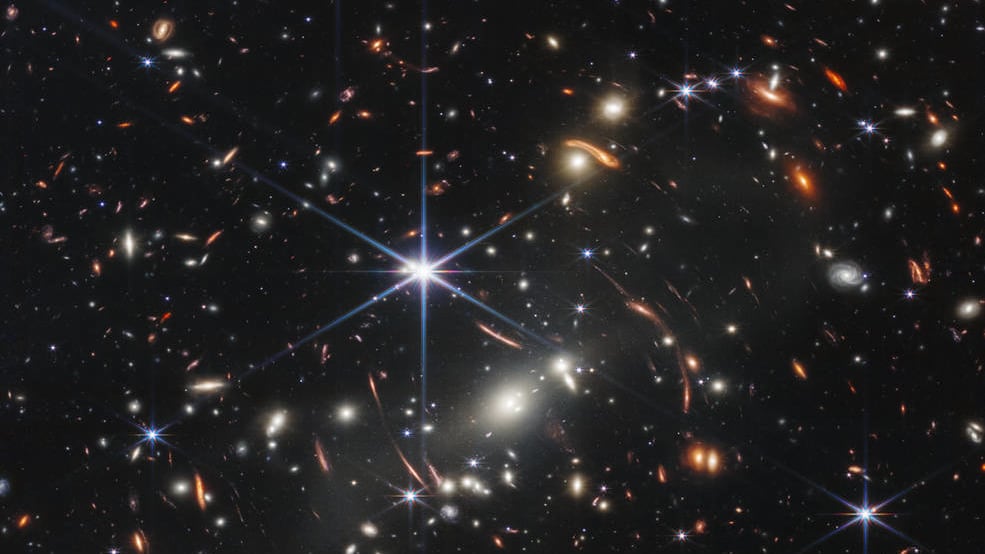From the White House early evening on Monday, President Biden had the privilege of publicly revealing the first full-color image taken by NASA’s James Webb Space Telescope—the most powerful observatory ever launched into space.
“Today is a historic day,” President Joe Biden told reporters Monday. “It shows what we can achieve… These images are going to remind the world that America can do big things.”
The new photo is a brilliant snapshot of SMACS 0723, a region of the night sky containing a galaxy cluster so massive that its gravity ends up bending light around it—magnifying and distorting bright objects in the background. SMACS 0723 creates a deep field view of very distant and faint populations of stars and galaxies.
“If you held a grain of sand at the tip of your finger at arm’s length, that’s the amount of space that you’re seeing,” said NASA administrator Bill Nelson. “You’re seeing just a small little portion of the universe.”

A deep field view of space in the direction of SMACS 0723.
Space Telescope Science Institute Office of Public OutreachLate last week, NASA had announced that the first batch of images would show off five distant targets. Besides SMACS 0723, the other four are:
- Carina Nebula: An ornate and complex region of interstellar clouds approximately 8,500 light years away. As with other nebulae, Carina is a stellar nursery—home to infant stars (plus middle-aged ones) and balls of supercharged gas on their way to becoming stars. This is one of the biggest and brightest nebulae known to astronomers.
- WASP-96 b: A giant planet 1,150 light years from Earth—well outside the solar system. This gaseous giant has half the mass of Jupiter but orbits its host star every 3.4 days. It has a gorgeous sheen to it thanks to the high sodium content in its atmosphere—and is remarkably free of clouds.
- Southern Ring Nebula: Also known as the “Eight-Burst” nebula, home to a dying star that’s hemorrhaging gas into a cloud stretching nearly a light year in diameter. The Southern Ring Nebula is 2,000 light years from Earth.
- Stephan’s Quintet: A compact galaxy group first discovered in 1877, 290 million light years away, with four of the five galaxies repeatedly encircling each other in a dance of close encounters.
The new images have been years in the making. JWST, commonly described as the successor to the 30-year-old Hubble Space Telescope, overcame years of delays, billions of dollars in excess costs, and a naming controversy before it was finally launched on Christmas Day last year.
“Now we enter a new phase of scientific discovery, building on the legacy of Hubble,” Vice President Kamala Harris told reporters Monday. “The James Webb Space Telescope allows us to see deeper into space than ever before, and in stunning clarity.”
The new telescope, sitting 1 million miles away in orbit around Earth and boasting the biggest mirrors ever used for a space observatory, specializes in looking at the universe through infrared and near-infrared light. Because light becomes stretched out as it travels longer distances, JWST is especially useful at looking at some of the farthest objects in the known universe—some as far as 13.7 billion light-years away.
That means we’re effectively using the telescope to look back 13.7 billion years ago—at the infancy of the universe. Scientists hope to use JWST to understand what the universe looked like in the immediate aftermath of the Big Bang.
“The light that you’re seeing from one of those tiny specks has been traveling 13 billion years,” said Nelson.
The mighty telescope will also be a key instrument in other astronomical investigations—including the search for planets that may be habitable to life.
NASA previously teased out the power of JWST in test images taken earlier this year. Those photos were already pretty stunning, but pale in comparison to the image of SMACS 0723 Biden and NASA unveiled Monday.
It won’t stop there. NASA will release images of the four other objects Tuesday morning. And after that, expect a constant stream of space photos unlike anything we’ve ever seen before.
“This telescope is one of humanity’s great achievements,” said Harris.






